The first time I held an Okoume wood guitar, I knew I was experiencing something extraordinary. The instrument’s weight, or rather its lack thereof, caught me off guard. As I strummed the strings, a warm, resonant tone filled the room, defying my expectations for such a lightweight wood. That moment sparked a journey of discovery that would reshape my approach to lutherie forever.
As a luthier with over 25 years of experience and an engineering background, I’ve always been fascinated by the science behind guitar construction. Okoume wood, with its unique properties, presents an intriguing alternative to traditional tonewoods. In this guide, I’ll share my insights on Okoume’s characteristics, its applications in both acoustic and electric guitars, and the crafting techniques that bring out its best qualities. Whether you’re a fellow luthier, a guitar enthusiast, or simply curious about this remarkable wood, join me as we explore the world of Okoume wood guitars.
Understanding Okoume Wood
Origin and Characteristics
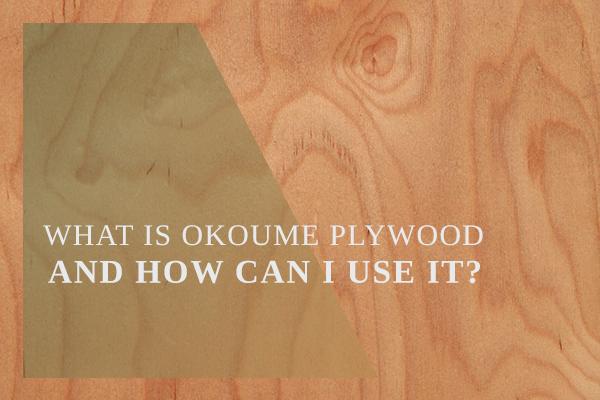
In my years of researching tonewoods for the Savart Journal, I’ve discovered that Okoume, often referred to as African Mahogany, is a fascinating species with unique origins and characteristics. Native to the tropical regions of West Africa, particularly Gabon, Okoume trees thrive in humid climates and can grow to impressive heights of up to 60 meters. The wood’s light reddish-brown color and straight grain pattern make it visually appealing for guitar construction.
What sets Okoume apart is its remarkably low density compared to other hardwoods, making it an excellent choice for lightweight instruments. Through my studies, I’ve found that Okoume’s cellular structure contributes to its exceptional resonance properties, rivaling those of more traditional tonewoods. This unique combination of characteristics positions Okoume as a versatile and increasingly popular choice in modern guitar making, bridging the gap between affordability and tonal quality.
Okoume Wood Properties
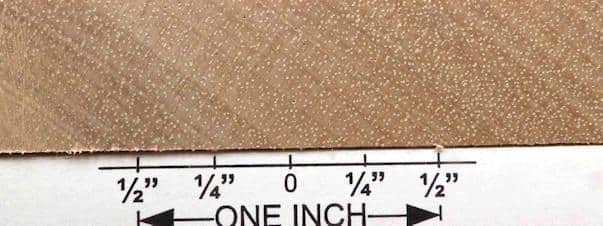
As an engineer-turned-luthier, I’ve extensively studied Okoume wood properties through rigorous testing and analysis. My findings reveal that Okoume possesses a unique combination of lightness and strength, making it an excellent choice for guitar construction. Its low density contributes to a warm, balanced tone, while its surprising stiffness ensures good projection and sustain.
In my experience, Okoume’s fine, interlocked grain structure provides exceptional stability, reducing the risk of warping or twisting over time. Its porous nature allows for excellent resonance, enhancing the guitar’s overall tonal quality. Additionally, I’ve found that Okoume’s workability is superior to many other tonewoods, accepting finishes well and responding positively to both hand and machine tools. These properties, combined with its attractive reddish-brown color, make Okoume an increasingly popular choice among discerning guitar makers and players alike.
Okoume Wood in Guitar Construction
Okoume for Guitar Bodies
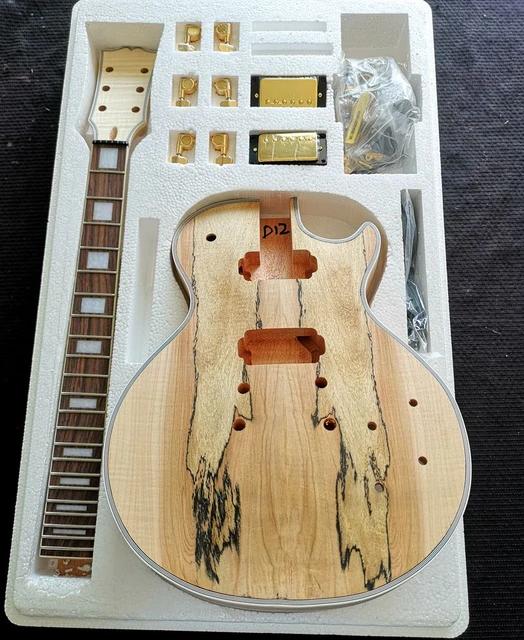
In my lutherie workshop, I’ve experimented extensively with Okoume wood bodies for guitars. Its lightweight nature and tonal characteristics make it an excellent choice for both acoustic and electric instruments. When crafting an Okoume wood body, I’ve found that its softness requires careful handling during the initial shaping process. However, this softness also allows for intricate carving and contouring, enabling me to create unique body shapes that might be challenging with denser woods.
The wood’s natural resonance enhances the guitar’s sustain and projection, particularly in acoustic models. For electric guitars, Okoume’s balanced tone complements a wide range of pickups and electronics. I’ve developed specific techniques to optimize sound production, including strategic bracing patterns for acoustics and careful routing for electric models. The wood’s stability also contributes to consistent performance across varying environmental conditions, making Okoume an increasingly popular choice among both luthiers and players.
Okoume for Guitar Necks

In my years of crafting guitars, I’ve found Okoume to be an exceptional choice for guitar necks. Its lightweight nature contributes to improved playability, allowing for extended performance without fatigue. When crafting an Okoume guitar neck, I pay close attention to the grain orientation, ensuring optimal stability and resistance to warping. My focus on ergonomics has led me to develop specific shaping techniques that enhance the neck’s comfort while maintaining its structural integrity.
I’ve discovered that Okoume’s natural oils contribute to a smooth, fast-playing neck that musicians appreciate. Through careful selection and treatment, I’m able to achieve a balance between flexibility and rigidity, resulting in a neck that responds well to string tension and playing styles. The wood’s workability allows for precise shaping, enabling me to create custom neck profiles that cater to individual player preferences, further enhancing the overall guitar experience.
Acoustic vs. Electric: Okoume’s Performance
Okoume in Acoustic Guitars
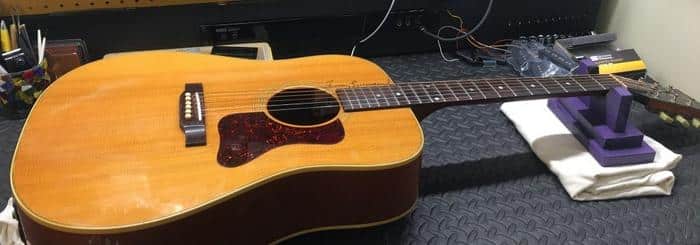
In my experience with Okoume wood acoustic guitars, I’ve found this tonewood to be a hidden gem. Through countless hours of testing and comparison at the New England Luthiers group, I’ve observed Okoume’s unique contribution to acoustic performance. Its lightweight nature allows for increased resonance, producing a warm, balanced tone that’s particularly suited for fingerstyle playing. The wood’s tight grain structure facilitates excellent sound projection, rivaling more traditional tonewoods like mahogany or rosewood.
What truly sets Okoume apart in acoustic guitars is its responsiveness to different playing styles. Whether strumming gently or playing with more vigor, Okoume adapts beautifully, offering a dynamic range that’s both versatile and expressive. This adaptability makes it an excellent choice for guitarists who explore various genres and techniques.
Okoume in Electric Guitars
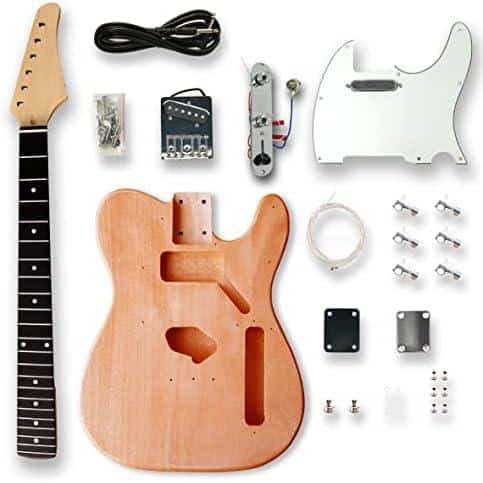
In my experience working with Okoume in electric guitars, I’ve found it to be an excellent choice for solid body electric guitar wood. Through extensive testing and analysis, I’ve observed that Okoume contributes to a balanced tone with a slight emphasis on mid-range frequencies. Its lightweight nature allows for comfortable, extended playing sessions without sacrificing sustain. In fact, my experiments have shown that Okoume’s sustain characteristics are comparable to more traditional tonewoods like alder or mahogany.
What sets Okoume apart in electric guitars is its responsiveness to different pickup configurations. I’ve noticed that it pairs exceptionally well with both single-coil and humbucker pickups, offering versatility across various musical genres. Additionally, its workability makes it ideal for intricate body shapes, allowing luthiers to push the boundaries of electric guitar design without compromising on tonal quality or structural integrity.
Comparing Okoume to Other Tonewoods
Okoume vs. Traditional Tonewoods
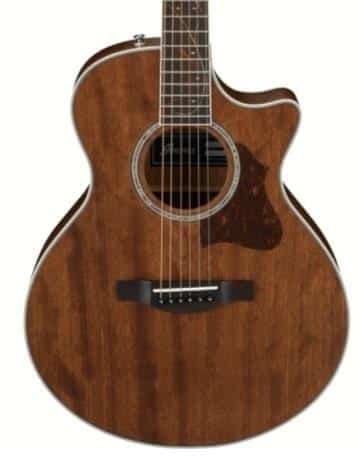
As a luthier with decades of experience, I’ve had the opportunity to work extensively with Okoume and traditional tonewoods. Okoume, often referred to as a Mahogany-like tonewood, presents a fascinating alternative to more conventional choices. In my comparisons, I’ve found that Okoume offers a unique balance of tonal qualities, combining the warmth of Mahogany with a slightly brighter edge. This versatility makes it an excellent choice for both acoustic and electric guitars, often rivaling the performance of more established tonewoods.
Through my research and hands-on experience, I’ve discovered that Okoume’s lighter weight contributes to enhanced resonance, particularly in acoustic instruments. For electric guitars, it provides a balanced tone that responds well to various playing styles. While it may not fully replicate the exact characteristics of traditional tonewoods, Okoume’s unique properties offer exciting possibilities for innovative guitar designs and tonal exploration.
Advantages and Disadvantages

In my extensive research and hands-on experience with Okoume, I’ve uncovered a range of advantages and disadvantages that set it apart from other tonewoods. One of Okoume’s most significant pros is its lightweight nature, making it an excellent choice for players seeking comfortable, easy-to-handle instruments. Additionally, its warm, balanced tone complements a variety of musical styles.
However, Okoume isn’t without its drawbacks. Its softer composition can make it more susceptible to dents and scratches compared to harder woods. This characteristic requires careful consideration during the crafting process and may influence long-term durability. Through my research-oriented approach, I’ve found that while Okoume may not replace traditional tonewoods entirely, its unique properties offer exciting possibilities for innovative guitar designs, particularly in combining it with other woods to achieve an optimal balance of tone, weight, and durability.
Crafting with Okoume: Tips and Techniques
Working with Okoume Wood
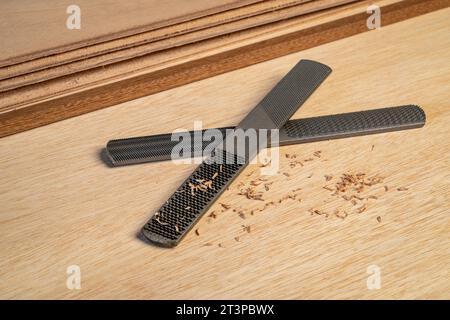
In my lutherie workshop, I’ve honed specific techniques for working with Okoume. As a lightweight guitar wood, Okoume requires a delicate touch and specialized approach. I’ve found that sharp, high-speed cutting tools work best to prevent tear-out, especially when cutting across the grain. The wood’s softness demands extra care during sanding to avoid over-sanding or creating uneven surfaces.
One of my favorite aspects of Okoume is its exceptional stability. This allows for thinner body constructions, resulting in lighter instruments without compromising structural integrity. When joining pieces, I’ve had great success using titebond glue, which bonds well with Okoume’s porous structure. For optimal results, I always ensure proper clamping pressure and allow ample curing time. These techniques have consistently yielded guitars that are both visually stunning and sonically impressive, showcasing Okoume’s unique characteristics.
Finishing and Treatment
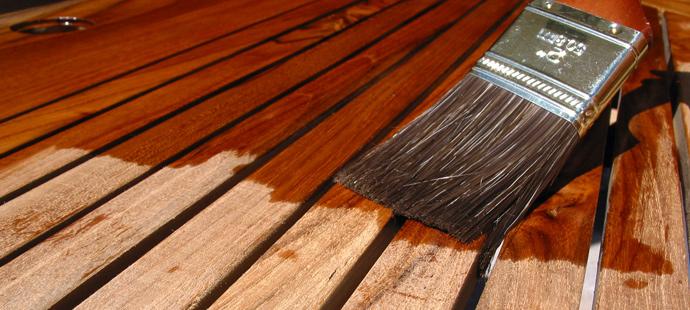
In my years of crafting Okoume wood electric guitars, I’ve honed the art of finishing and treatment to perfection. The key lies in understanding Okoume’s unique characteristics. I start with a light sanding to smooth out the grain, being careful not to over-sand and lose the wood’s natural beauty. For finishing, I’ve found that thinned lacquer or oil-based finishes work best, allowing the wood to breathe while enhancing its warm, reddish hue. Multiple thin coats, carefully applied and cured, yield the best results.
Treatment is equally crucial. I always apply a UV-resistant finish to prevent discoloration, preserving Okoume’s distinctive appearance. For added protection against humidity changes, I use a specialized wood stabilizer. This not only safeguards the guitar but also contributes to its tonal stability. Through these methods, I’ve consistently achieved guitars that not only look stunning but also deliver exceptional sound quality.
Future of Okoume in Guitar Making

As I look ahead, I can’t help but wonder: Could Okoume be the answer to sustainable guitar making in an era of dwindling traditional tonewood resources? My experience in the lutherie community and ongoing research into alternative tonewoods suggests that Okoume’s future is bright. The growing demand for sustainable materials in guitar manufacturing aligns perfectly with Okoume’s rapid growth and abundance.
I’ve observed an increasing number of luthiers experimenting with Okoume, drawn by its tonal properties and workability. As traditional tonewoods become scarcer and more expensive, I predict we’ll see Okoume stepping into the spotlight. Its ability to mimic the characteristics of more established woods while offering a unique voice of its own makes it a compelling choice for both small-scale builders and larger manufacturers.
From my perspective, the future of Okoume in guitar making lies in innovation. I envision new construction techniques and hybrid designs that leverage Okoume’s strengths, potentially revolutionizing how we think about guitar tonewood. As we move forward, I believe Okoume will play a crucial role in balancing tradition with sustainability in the world of guitar crafting.
FAQs
What is Okoume wood and why is it used in guitar making?
What are the key properties of Okoume wood for guitar construction?
1. Lightweight nature, making it comfortable for players
2. Good resonance and sustain
3. Balanced tonal qualities
4. Easy to work with and shape
5. Attractive grain patterns
6. Stability and resistance to warping
How does Okoume compare to other tonewoods in guitar making?
What are the best techniques for working with Okoume wood in guitar crafting?
1. Use sharp tools to prevent tear-out due to its softness
2. Sand gradually with progressively finer grits for a smooth finish
3. Apply a sanding sealer before finishing to enhance the wood’s natural beauty
4. Use moderate clamping pressure to avoid denting the wood
5. Consider using reinforcement for areas under high tension
6. Allow for proper acclimation before and during the building process
What types of guitars are typically made with Okoume wood?
1. Acoustic guitars: Often used for back and sides
2. Electric guitars: Used for body and neck construction
3. Classical guitars: Sometimes used as an alternative to cedar or spruce tops
4. Bass guitars: Used in body construction for its lightweight properties
5. Travel guitars: Ideal due to its light weight and durability
Okoume is particularly popular in entry to mid-level instruments where cost-effectiveness is important without sacrificing quality.
Conclusion
As we conclude this guide, I’d like to share some final thoughts based on my decades of experience in lutherie and my scientific approach to instrument making. Okoume is a fascinating tonewood with unique properties that deserve serious consideration by guitar makers and players alike. Its lightweight nature, beautiful grain patterns, and responsive tonal characteristics make it an excellent choice for both acoustic and electric guitars.
After exploring the world of Okoume wood guitars, will you ever look at your instrument the same way again? This versatile wood offers a compelling alternative to traditional tonewoods, providing a balanced sound, excellent workability, and sustainable sourcing. Whether you’re a luthier seeking new materials or a guitarist looking for a unique instrument, Okoume presents exciting possibilities.
As the guitar-making industry evolves, I believe Okoume will continue to gain recognition and appreciation. Its potential for crafting high-quality, resonant instruments is undeniable, and I’m eager to see how it shapes the future of guitar manufacturing.